Alan Shepard: Moonwalker and 1st American in Space
Alan Shepard was a former military pilot and astronaut. He was the first American in space and was the fifth person to walk on the Moon. He was born on Nov. 18, 1923, in Derry, N.H. A very intelligent student, Shepard skipped both the 6th grade and the 8th grade and then attended the Pinkerton Academy for the last four years of his secondary schooling, graduating in 1940. 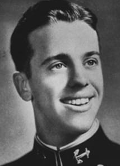
He quickly joined the US. Navy and was assigned to the Admiral Farragut Academy because he was too young to enroll at the Naval Academy. He got his spot in Annapolis the following year and graduated in 1944. After that, he saw active duty in the Pacific. He was on the destroyer USS Cogswell during the Battle of Okinawa and in Tokyo Bay as the Japanese forces surrendered, ending the war. Shepard, who had married Louise Brewer during the war, entered flight training at the Corpus Christi, Texas, Naval Air Station and then progressed to advanced training in Pensacola, Fla. In 1948, he was assigned to an aircraft carrier group patrolling the Caribbean. A keen, skilled pilot, Shepard entered the Test Pilot School at Patuxent River in 1950. He was eventually an instructor at the school and then entrolled at the Naval War College, in Newport, R.I., from which he graduated in 1957. In that same year, the launch by the Soviet Union of the satellite Sputnik electrified the world and lit a fire under the American space program. The National Aeronautics and Space Administration (NASA) came online the following year and soon afterward named its first group of astronauts, the Mercury Seven. Shepard was one. Tapped to be the first of the Project Mercury astronauts to fly, Shepard had an original flight date of April 26, 1960. That would certainly have made him the first human to orbit the Earth. However, his flight was delayed again and again, for months. The date was finally set, with all in readiness, for May 5, 1961. The Soviet cosmonaut Yuri Gagarin orbited the Earth for 108 minutes on April 12, 1961, making him the first human in space. Once again, the Soviets had been first. 
Shepard did fly on May 5, spending just more than 15 minutes orbiting Earth, aboard Freedom 7. He played other important roles in the Mercury program, serving as capsule communicator (CAPCOM) for the flight of John Glenn and Scott Carpenter and as the backup pilot for Gordon Cooper. The organizers of the two-man Project Gemini designated Shepard as the commander of the first Gemini mission, but a diagnosis of Mèniére's disease, an inner ear disorder, grounded him for four years. During this time, he served as Chief of the Astronaut Office and was in charge of astronaut training. He was also on the selection panel for Astronaut Group 5. In 1968, he had radical surgery that eliminated his inner ear condition and was cleared to fly. By this time, NASA was on to the Apollo missions. 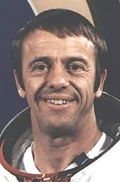
Shepard was the commander of Apollo 14, the third crew to land people on the Moon. Shepard, at 47, was the oldest man to walk on the lunar surface. He was also the member of Project Mercury to do so. He and Edgar Mitchell were on the surface of the Moon for 33 hours and did two sessions of extravehicular activity (EVA), totaling more than nine hours. They performed experiments similar to those done by previous crews, including setting up some that would remain when they left; this crew, however, had a pull cart for carrying equipment. The cart came in handy for towing things around and having supplies ready to hand, but it became a nuisance when the astronauts had to carry it over rough terrain. One of the goals of the second EVA to to reach the rim of Cone Crater, which was 1,000 feet tall. Because the slopes of the crater were so many, Shepard and Mitchell had to turn back because of low oxygen supply in their space suits before they reached the rim; later analysis showed that they were just 100 feet away from their goal. 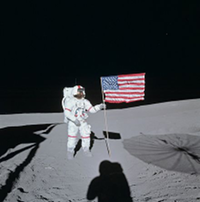
The crew brought back rocks from the lunar surface, including the famous Big Bertha, at 20 pounds the third-largest Moon rock retrieved; in 2019, scientists concluded that the rock was 4 billion years old and that it probably originated on Earth. Just before they got back in the Lunar Module, the astronauts engaged in a bit of sports-related research. Shepard had brought two golf balls and the head of a 6-iron golf club, which he affixed to one end of a tool that he and Mitchell had been using for soil excavation. Shepard took one swing at each golf ball (using just one hand so as not to tip over in the bulky space suit) and connected both times, sending both balls flying through the air. Mitchell took his turn, throwing a tool as if it were a javelin. 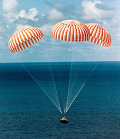
The rendezvous with Stuart Roosa, who had been taking photos and scouting the proposed landing site for Apollo 16 in the Command Service Module was uneventful, as were the trip home and the splashdown, the latter of which occurred on February 9 in the South Pacific Ocean. Apollo 14 was the last of the lunar landing crews to undergo quarantine. They were shut away for 17 days. Shepard resumed his position as Chief of the Astronaut Office in 1971 but was then named to the United Nations General Assembly, in which capacity he served for a few months. He retired from both the Navy and NASA in 1974. He spent considerable time in the private sector, serving on the board of several corporations. He helped start the Mercury Seven Foundation, which was renamed the Astronaut Scholarship Foundation, to help science and engineering students graduate from college. 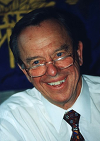
Shepard worked with Jay Barbree, Howard Benedict, and Deke Slayton to write the book Moon Shot: The Inside Story of America's Race to the Moon. The book was published in 1994 and was the basis of a television series later that year. He was diagnosed with leukemia in 1996 and died two years later, on July 21, 1998. His wife died not long afterward. They had three children. |
|
Social Studies for Kids
copyright 2002–2025
David White




